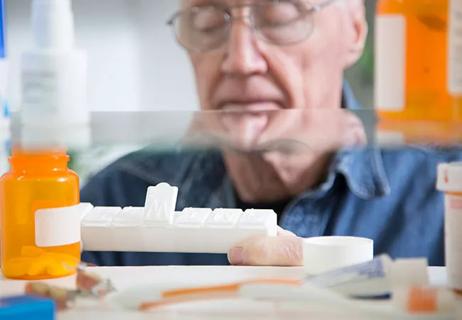Although the diagnosis and treatment processes are often straightforward, it’s important to be timely with initiating both

Elevated calcium levels in a patient’s blood work can be indicative of a number of conditions. Among the most common, as well as one of the most serious if left untreated, is hyperparathyroidism. However, many patients with hyperparathyroidism present asymptomatically, and because timeliness is so imperative, it’s critical that clinicians are thorough and expedient.
Cleveland Clinic is a non-profit academic medical center. Advertising on our site helps support our mission. We do not endorse non-Cleveland Clinic products or services. Policy
“Hyperparathyroidism is actually a relatively common diagnosis,” explains Susan Williams, MD, a staff clinician in Cleveland Clinic’s Endocrinology & Metabolism Institute. “Looking back, things really changed in the 1970s when common blood tests like serum calcium were being done routinely, and all of a sudden, the diagnosis of primary hyperparathyroidism became extraordinarily common because we could now detect and monitor high levels of blood calcium.”
Dr. Williams explains that there are several reasons a patient could present with elevated calcium levels, which is why it’s important to be detailed in the patient’s workup. For example, the patient could be taking too many supplements or other medications that are causing the high calcium levels. Elevated calcium can also be indicative of more severe diseases such as cancer or multiple myeloma. At Cleveland Clinic, the cutoff for the normal range of calcium is 10.2, but this varies depending on the lab assay that a particular lab is using. Other hospital systems can vary both at the bottom of the normal range as well as the top of the normal range, but it is usually between 10 to 10.8.
Dr. Williams says that the time from the patient’s presentation to treatment can vary wildly. “Usually by the time a patient is sent into us, that calcium has been elevated sometimes for six months,” says Dr. Williams. “But sometimes it’s been present for 10 years, and that calcium has just kind of smoldered along just about a point or so higher than the normal range cutoff. Oftentimes though, they’ll come to us, they’ll have high calcium. They will have had repeat episodes of kidney stones. A study written by our Endocrine Surgery faculty looked at the time from that first instance of elevated calcium to surgery. They found that it was about three and a half years or so.”
The first-line treatment for hyperparathyroidism is parathyroidectomy, and most importantly, the surgery is curative. Parathyroid disease often is progressive, and when it is progressive, other organ systems become effected, sometimes, severely. The elevated calcium levels indicate that there is bone loss because that high calcium is coming from the skeleton. That high circulating calcium can be very detrimental to the kidneys, and can lead to kidney stones, and sometimes in very severe cases, calcium can precipitate into other organs and even the skin, which becomes extremely painful. So if the surgeon can identify the parathyroid gland or glands that are overactive and causing the problem and remove them, then they can cure the patient.
The surgery is usually straight-forward. Typically, the patient is brought into the hospital the day of the surgery and is usually kept overnight. The surgical incision itself is usually only about an inch or so, and the time in surgery is relatively short. During the course of the surgery, when that offending parathyroid is taken out, the labs are actually tested in surgery. There is often a dramatic drop in the calcium and the parathyroid levels almost immediately. The patients are kept in recovery, and the labs are tested again the next morning.
“The reason they test the labs the next morning is because the elevated blood calcium was due to loss of bone mineral. When the overactive pararthyroid gland(s) are removed, the bones then become ‘hungry” and naturally work to regain the mineral lost. Because of this, the blood calcium can drop low enough that the patients become uncomfortable,” explains Dr. Williams. “So we make sure that the patients have adequate calcium and adequate vitamin D. We actually have them take a little bit higher than normal doses, again, to help the bones remineralize. Another thing that can happen, though this too is rare, is sometimes the other parathyroids in the neck are just stunned a little bit from the surgery and they’re not picking up the slack right away, and so we just have to watch the patient carefully and make sure they’re supplemented appropriately.”
Because the diagnosis and treatment are both fairly simple and straightforward, the most important action clinicians can take to improve hyperparathyroidism care is reducing the time between a patient initially presenting elevated calcium levels to getting them into surgery. Endocrinologists often rely on other specialty groups, such as urology, nephrology, gastroenterology and internal medicine, so it’s important to work closely with these specialists to make sure that if they’re seeing these elevated calcium levels to either perform the necessary blood work or refer to endocrinology.
“Don’t shy away from retesting that calcium,” says Dr. Williams. “If you see a calcium that’s significantly elevated and you have eliminated the obvious like the patient is taking too many antacid tablets for upset stomach, or high calcium supplementation that’s not necessary, and the calcium remains high, get them to us right away. Once we see them, we can rapidly complete needed testing and get them referred to one of our expert Endocrine surgeons. Hyperparathyroidism is one of the ‘bread and butter’ diagnoses that we see in our clinic, and it is one of many conditions that we can effectively treat.

Screening and medication key to better outcomes

While the skeletal effects of nutrient deficiency are well-known, it’s important to consider how deficiency impacts the endocrine system

The tool can provide better clarity on evaluation of indeterminate thyroid nodules, reduce the number of unnecessary surgeries and help providers tailor patient care

Guidance for counseling patients on the use of one of the most common daily supplements taken in the US

Two case studies illustrate why it’s important to look at DXA data holistically when treating patients with fracture risk

Because treatment options are reserved for classic Cushing’s, monitoring changes is critical in the management of subclinical Cushing’s

Following a PCP referral, patients often meet with several specialists, including an endocrinologist who helps them achieve their GAHT goals

For women who have struggled with infertility, a lifestyle change may be the answer